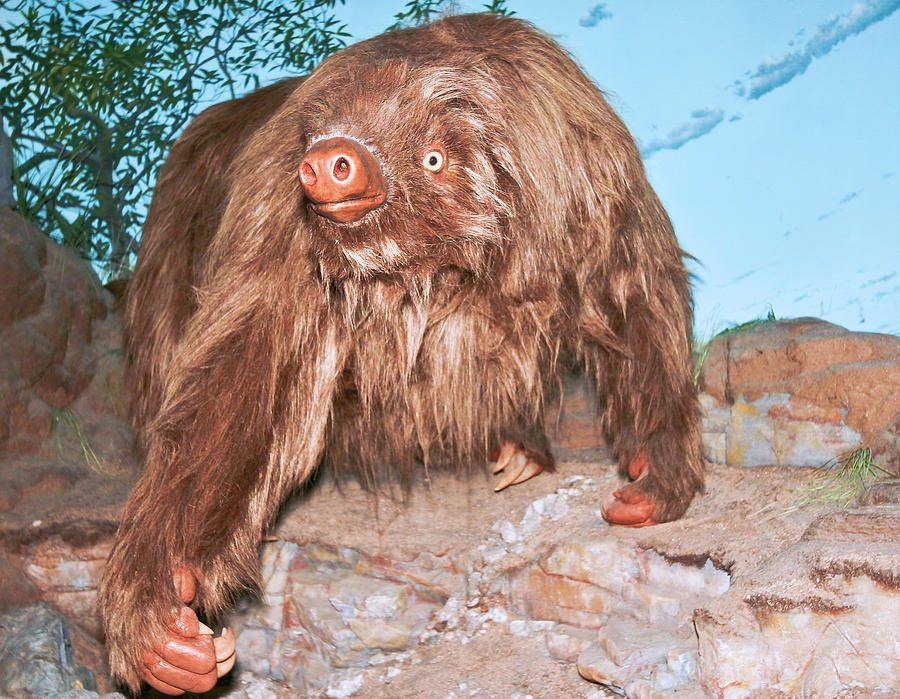
The Shasta Ground Sloth is known from central Mexico through most of the American Southwest. Nothrotheriops was not closely related to two- nor three-toed tree sloths that are alive today in Central and South America Distribution and Habitat The intermittent movement of different types of animals between North and South America throughout the Pliocene and Pleistocene epochs is known as the “Great American Biotic Interchange.” This phenomenon brought today’s opossums, porcupines, and armadillos to North America and today’s foxes, lamine camels (llamas), and small cats to South America. The ancestors to Nothrotheriops evolved initially in South America and then crossed the Isthmus of Panama to North America roughly 2.6 million years ago. The first fossils of the Shasta Ground Sloth were described in 1905. It had a long, slender skull with a narrow mouth that might have supported a long prehensile tongue. The front feet bore large claws for grabbing branches and helping defend itself from large predators. It was approximately 9 feet long and weighed up to 550 pounds. The Shasta ground sloth was a large ground dwelling sloth, but one of the smallest ground sloths to live in North America during the late Pleistocene. Megatherium and Megalonyx are distant relatives of today’s modern Two- and Three-fingered sloths that live in Central and South America.The Shasta ground sloth is one of the two species of giant ground sloth found from Tule Springs Fossil Beds National Monument. As big as it was, though, Megalonyx was a mere pup compared to the truly giant Megatherium. In 2010, the first specimen ever found in Colorado was discovered at the Ziegler Reservoir site near Snowmass Village (in the Rocky Mountains at an elevation of 8,874 feet). Why the Giant Ground Sloth, as with other megafauna of the Miocene epoch, grew to such enormous size is a mystery.īesides their bulk, these sloths were distinguished by their significantly longer front than hind legs, a clue that they used their long front claws to rope in copious amounts of vegetation. It was the only ground sloth to range as far north as the present-day Yukon and Alaska. Fossils are known from many Pleistocene sites in the United States, including most of the states east of the Rocky Mountains as well as along the west coast. jeffersonii was apparently the most wide-ranging giant ground sloth. The forelimbs had three highly developed claws that were probably used to strip leaves and tear off branches. The hind limbs were plantigrade (flat-footed) and this, along with its stout tail, allowed it to rear up into a semi-erect position to feed on tree leaves. Like other ground sloths it had a blunt snout, massive jaw nd large, peg-like teeth. This is medium-sized among the giant ground sloths. Its maximum weight may have been as much as 800 pounds. Megalonyx jeffersonii, of the family Megalonychidae, was a large, heavily built animal about 8 to 10 feet (2.5–3 m) long. The name was proposed by Thomas Jefferson in 1797, based on fossil specimens found in a cave in West Virginia. Megalonyx (“great claw”) is the Greek name for another of the giant ground sloths. Little evidence available causes these gaps in our knowledge about the Giant Ground Sloth. Yet another theory suggests that disease terminated these giants of the Americas. Many of them may have been eaten by their new neighbors. The southern herbivores had not learned to be cautious as they traveled north. During the Great American Interchange, northern animals learned to watch out for carnivores that traveled south at the same time they did. Among them is the suggestion that fast changes of climate killed them, or that human hunters that had crossed into Alaska killed them for food as they moved throughout North America.Īnother theory hypothesizes that these southern sloths had lived on an island that held few carnivores for thousands of years.

Theories abound in the scientific world about the disappearance of these creatures. Megatherium (“giant beast” in Latin) lived from about 35 million to 11,000 years ago, coinciding with the last Ice Age. This giant stood seven meters tall and weighed seven tons.

The largest and grandest of these was the Megatherium, the extinct genus of the family Bradypodidae. Paleontologists have identified an amazing variety of fossils of at least 23 different kinds and sizes of prehistoric sloths. Salvador, a life-size replica of the extinct Giant Ground Sloth, greets visitors entering the Sloth Sanctuary.


 0 kommentar(er)
0 kommentar(er)
